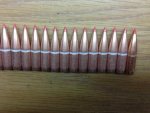I tried Moly but found it too fussy. When I found out about WS2 (tungsten disulphide), I went through a couple of ounces of it, and found it cured the complaints I'd had with Moly. When that ran out, I switched to hBN, just because it was something new, and because I got a killer deal on a pound of it. Application-wise, and performance-wise, I can't tell any difference between WS2 and hBN, but I think the hBN coating might be a bit more durable, less prone to scuffing and minor blemishes.
This probably sounds petty but I like the color of hBN better because it doesn't look so obviously different from nekkid. I'd got tired of being interrogated about my black bullets every time I went to a public range to shoot WS2. And WS2 left an indelible black stain on any fabric I spilled it on (especially the cotton diapers I used for the final polish). hBN powder is white, so if it stains, it isn't noticeable.
Chamber pressure will come down with the slick bullets, but MV doesn't fall by an equivalent proportion. QuickLoad internal ballistics software ballparks the pMax reduction, IIRC, at 2000-3000 psi. Which means factory load specs for nekkid bullets are not directly applicable to slick bullets. I know some rabid crow hunters (rabid hunters, not rabid crows) who'd load their 220 Swifts and 22-250s to 6000 fps, if they thought they could get away with it. They shoot slick bullets, and load progressively hotter until either they get one of the customary symptoms of an overpressure (stiff bolt lift, extractor mark, top-hatted primers, etc) or their bullets begin failing in flight. That's how they determine their "slick bullet" max loads. Me, I'm not that adventurous. Until I manage to save up enough to buy myself a PressureTrace II, my comfort zone only extends up to the predicted MV of the factory's max charge weight, if that high.
I don't shoot out barrels fast enough to have a dog in that fight but several highly regarded gun guys, Walt Berger and Bryan Litz among them, are positive that slick bullets extend barrel life. It definitely reduces barrel heating, which could be the mechanism that improves barrel life, especially in high volume shooting sessions. I've read guesstimates of 5%-15% improved, but I can't see where the extra bother of coating my own bullets is worth an added 15% barrel life if that's all I'm doing it for.
I started prepping barrels with
Lock-Ease colloidal graphite before I started loading slick bullets, primarily because it reduces the POI shift in the CBS. Just for giggles, when I still was using WS2, I tried substituting Lock-Ease for the WS2/alcohol. Couldn't tell a lick of difference, but the Lock-Ease is simpler to apply because you don't have to mix anything, and it comes in its own squirt bottle. So I still use it with hBN. And I already was using it in everything I shoot nekkid bullets through, so it wasn't like I had to add something else to my reloading shelves. I tried the aerosol once, because it was easier to find, but it was worthless. Definitely stick with the liquid squeeze bottle.



